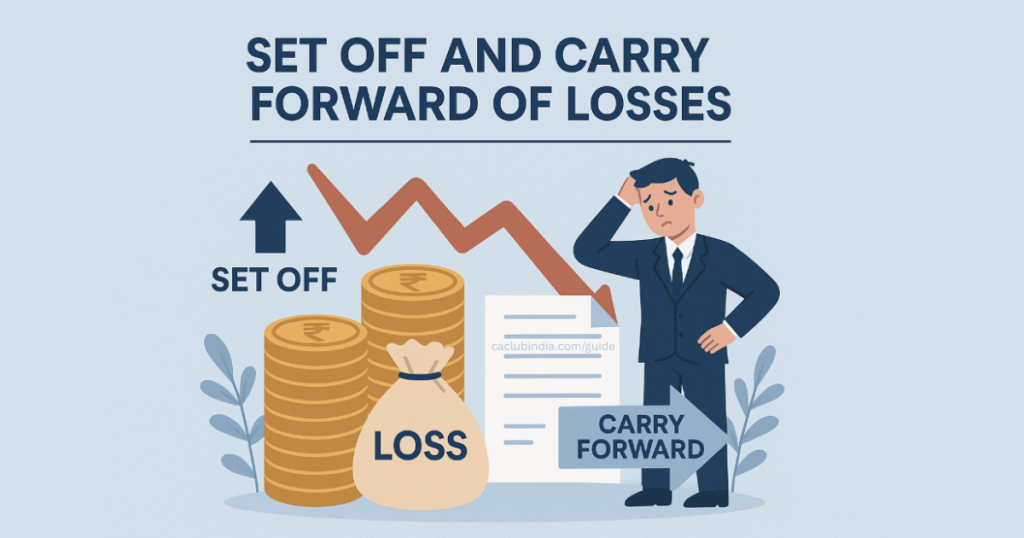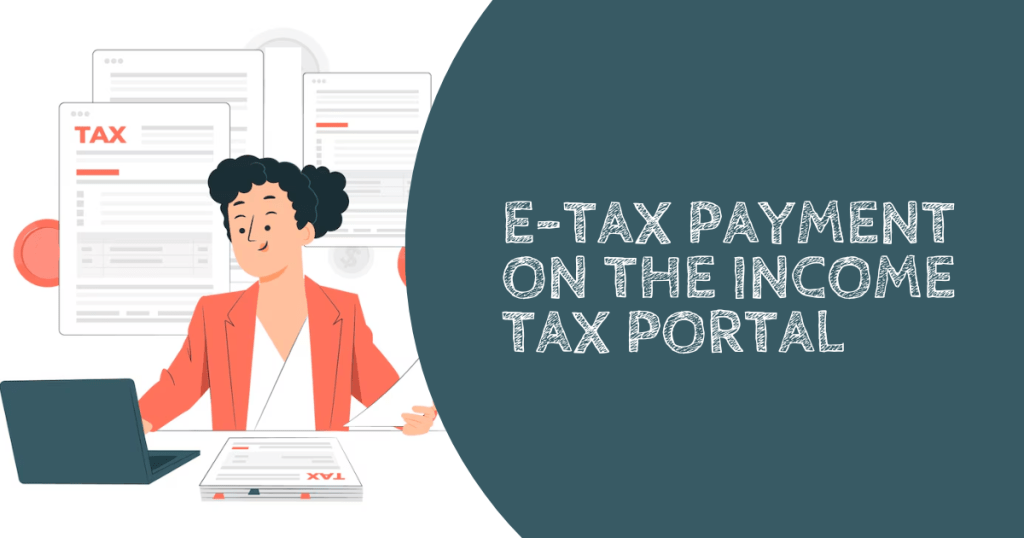Set off and Carry forward of losses refer to adjusting losses incurred under one head of income or in one year against income under the same or another head, either in the same year (set off) or in future years (carry forward).

Set Off of Losses
Intra-head Set Off (Section 70)
- Loss from one source of income can be set off against income from another source under the same head.
- Example: Loss from one house property can be adjusted against income from another house property.
Exceptions:
- Speculative losses can only be set off against speculative income.
- Long-term capital loss (LTCL) can only be set off against long-term capital gains.
- Loss from owning and maintaining race horses can only be set off against income from the same activity.
Inter-head Set Off (Section 71)
- After intra-head adjustment, remaining loss can be set off against income from another head.
- Example: Loss under “House Property” can be adjusted against salary income, business income, etc.
Restrictions
- Business loss cannot be set off against salary income.
- Loss under capital gains cannot be set off against any other head of income.
House Property Loss
- Set off against: House Property Income only
- Carry forward allowed for: 8 Assessment Years
- Max set off allowed in a year: ₹2,00,000 (as per current limits)
- Filing of return: Can be carried forward even if return is filed late
Business Loss (Non-speculative)
- Set off against: Any business income (not salary)
- Carry forward allowed for: 8 Assessment Years
Conditions:
- Return must be filed within due date under Section 139(1)
- The same business need not continue in future years
Speculative Business Loss
- Set off against: Only speculative business income
- Carry forward allowed for: 4 Assessment Years
Conditions:
Return must be filed within due date
Capital Loss
| Type | Set off against | Carry forward period |
| Short-term | STCG or LTCG | 8 AYs |
| Long-term | Only LTCG | 8 AYs |
Conditions:
- Return must be filed within due date.
- Cannot be set off against salary, business, or house property income.
Loss from Owning and Maintaining Race Horses
- Set off against: Income from the same activity only
- Carry forward allowed for: 4 Assessment Years
- Return filing: Must be on time
Unabsorbed Depreciation (Section 32)
- Set off against: Any income (except salary)
- Carry forward period: Unlimited
- No time limit for carry forward or set off
Even if the return is not filed on time, this depreciation can still be carried forward.
Important Notes
- Losses can only be carried forward if return is filed on or before due date, except for:
- House Property Loss
- Unabsorbed Depreciation
- Losses are to be set off and carried forward in a prescribed order.
Order of Set-Off (if multiple types of loss)
- Current year depreciation
- Current year business loss
- Brought forward business loss
- Unabsorbed depreciation
Carry Forward of Losses
If loss cannot be fully set off in the same year, it can be carried forward to future years.
| Type of Loss | Set Off Against | Carry Forward Period | Filing Condition |
| House Property Loss | Income from house property | 8 Years | Can be carried forward even if return is filed late |
| Non-Speculative Business Loss | Business income | 8 Years | Return must be filed within due date |
| Speculative Business Loss | Speculative business income | 4 Years | Return must be filed within due date |
| Short-Term Capital Loss (STCL) | STCG and LTCG | 8 Years | Return must be filed within due date |
| Long-Term Capital Loss (LTCL) | Only LTCG | 8 Years | Return must be filed within due date |
| Loss from Owning Race Horses | Income from same activity | 4 Years | Return must be filed within due date |
| Unabsorbed Depreciation (Section 32) | Any income (except salary) | Unlimited | Can be carried forward even if return is filed late |
Key Amendments Introduced in Union Budget 2025
Limitation on Carry Forward of Losses in Amalgamations and Business Reorganizations
Previous Provision:
Under Sections 72A and 72AA, in cases of amalgamation or business reorganization, the accumulated losses and unabsorbed depreciation of the predecessor entity were allowed to be carried forward by the successor entity for a fresh period of 8 years from the year of amalgamation.
Amendment:
To prevent indefinite carry forward of losses through successive amalgamations, the Finance Bill 2025 proposes that such losses can now be carried forward only for the remaining period out of the original 8 years from the year they were first computed by the predecessor entity. This change ensures that the total period for which losses can be carried forward does not exceed 8 years from the initial computation year.
Effective Date: Applicable to amalgamations or business reorganizations effected on or after April 1, 2025.
Clarification on Change in Shareholding for Closely Held Companies
Previous Ambiguity:
Section 79 restricts the carry forward of losses in closely held companies if there is a change in shareholding beyond 49%. However, there was ambiguity regarding whether the 49% threshold needed to be maintained continuously from the year of loss incurrence to the year of set-off.
Amendment:
The proposed amendment clarifies that if the shareholding changes beyond 49% at any time after the year in which the loss was incurred, the company loses the right to carry forward and set off such losses. This ensures that companies cannot circumvent the provision by temporarily adjusting shareholding patterns.
Effective Date: To be notified upon enactment of the Finance Bill 2025.
Practical Implications
- Tax Planning: Companies must carefully plan amalgamations and shareholding structures to ensure compliance with the revised provisions and to retain the benefit of loss carry forward.
- Return Filing: Timely filing of income tax returns is crucial to avail the benefit of carrying forward losses, especially for business and capital losses.
- New Tax Regime Consideration: Under the new tax regime, certain deductions and exemptions are not available. Taxpayers should evaluate the impact on loss set-off and carry forward when opting for the new regime.
FAQs
Yes. As per Section 71, house property loss (up to ₹2,00,000) can be set off against salary income or other heads of income (except capital gains).
You can carry forward non-speculative business losses for 8 assessment years, provided the return is filed on or before the due date under Section 139(1).
Yes: Loss from house property and unabsorbed depreciation can still be carried forward.
No: Business losses and capital losses cannot be carried forward if the return is filed after the due date.
The Finance Bill 2025 limits the carry forward of accumulated losses in case of amalgamation or reorganization to the remaining period within the original 8 years from the year the losses were first incurred.
The amendment clarifies that if the 51% shareholding continuity condition is violated at any time after the year in which the loss was incurred, the loss cannot be carried forward.
No. Speculative business loss can only be set off against speculative business income. It can be carried forward for 4 years.

